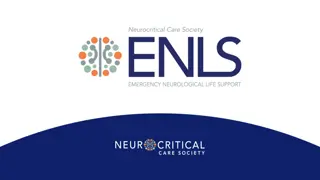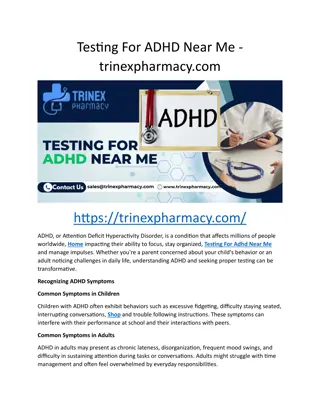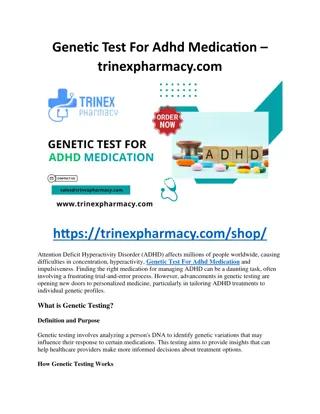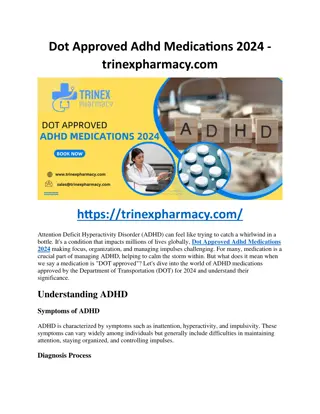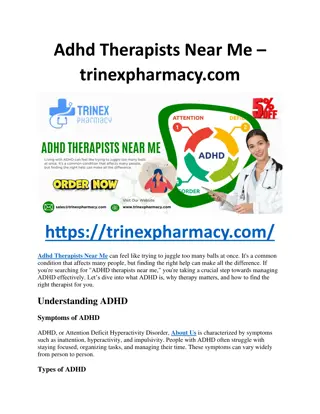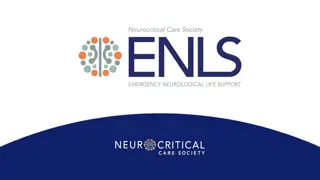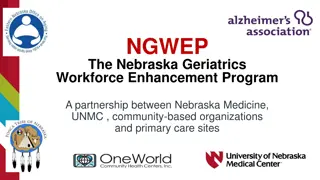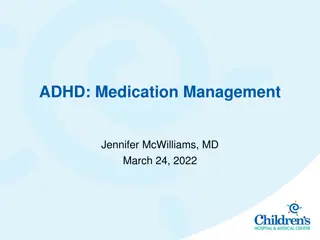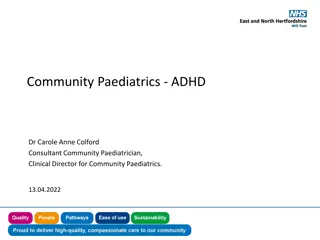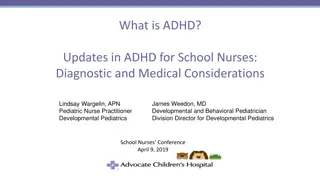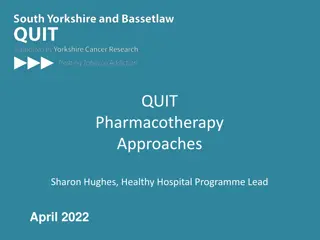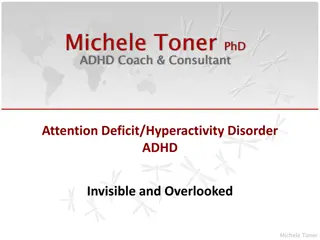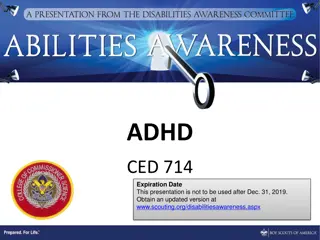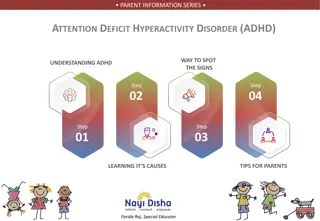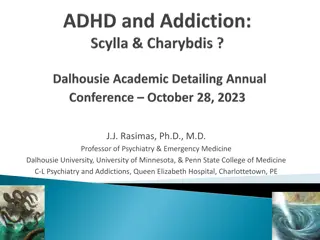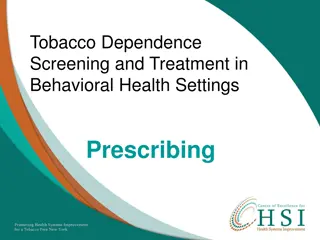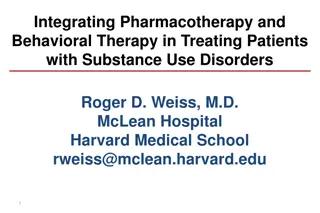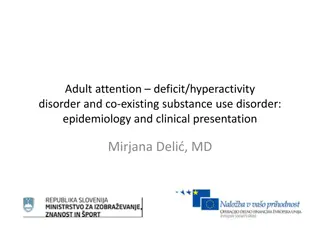Pharmacotherapy in ADHD
This content covers the pharmacotherapy and mechanisms of action in treating ADHD, focusing on drugs like methylphenidate, neural network dysfunctions, catecholamines in the brain, and the impact of norepinephrine and dopamine on cognitive functions. It also explores the effects of psychostimulants on arousal and cognition, along with their alterations in executive functions, providing valuable insights into ADHD treatment approaches.
Download Presentation

Please find below an Image/Link to download the presentation.
The content on the website is provided AS IS for your information and personal use only. It may not be sold, licensed, or shared on other websites without obtaining consent from the author.If you encounter any issues during the download, it is possible that the publisher has removed the file from their server.
You are allowed to download the files provided on this website for personal or commercial use, subject to the condition that they are used lawfully. All files are the property of their respective owners.
The content on the website is provided AS IS for your information and personal use only. It may not be sold, licensed, or shared on other websites without obtaining consent from the author.
E N D
Presentation Transcript
Pharmacotherapy in ADHD SARA DEHBOZORGI
Mechanism of Action Methylphenidate promotes release of stored dopamine and blocks the return of dopamine at presynaptic transporter sites. It leads to enhance dopamine function in striatum and the prefrontal cortex Preventing the reuptake of cathecholamines into presynaptic nerve. Preventing the degradation of cathecholamines by MAOIs.
Neural network in ADHD Many of the symptoms of attention-deficit/hyperactivity disorder (ADHD) are thought to arise from dysfunction of the prefrontal cortex (PFC) and its connections with cortical and subcortical brain regions. Current data suggest that the lateral PFC regions regulating attention and behavior are especially sensitive to the influence of norepinephrine (NE) and dopamine (DA)
Cathecolamines The arousal pathways (e.g., norepinephrine, dopamine, acetylcholine, serotonin,) all project to the PFC. It is now known that both NE and DA have an inverted-U dose effect on PFC function, whereby either too little (e.g., fatigue) or too much (e.g., uncontrollable stress) impairs PFC function, while moderate levels of catecholamine released when a subject is alert.
Norepinephrine Moderate levels of NE released during alert, nonstressed waking improve working memory performance by engaging postsynaptic, alpha 2A receptors , whereas high levels of NE released during stress impair PFC function via stimulation of lower affinity alpha1 and beta 1 receptors.
Psychostimulants and motivated behavior: Arousal and cognition Psychostimulants are a class of drugs defined by their potent arousal-enhancing, motor- activating and reinforcing effects. Neurochemically, psychostimulants block dopamine (DA) and norepinephrine (NE) transporters, elevating extracellular levels of these transmitters .
Psychostimulant-induced alterations in executive function The qualitative differences in the electrophysiological effects of varying levels of NE and DA within the PFC likely contribute to the diverse behavioral effects of varying doses of psychostimulants in humans, with therapeutic actions occurring at low doses and loss of self- regulation at high and abused doses. Consistent with this, high doses of psychostimulants impair PFC-dependent function.
STIMULANTS Methylphenidate (Ritalin) D-Methylphenidate (Focalin) Dextroamphetamine (Dexedrine) D,L-amphetamine (Adderall)
Long acting stimulants: Sustained release (Ritalin SR 20 mg) Extended release (Metadate ER 10 mg, 20 mg) Extended-release capsules (Ritalin LA 10, 20, 30, and 40 mg) Their durations of action are approximately 8 hours Osmotic Release Oral System-OROS- (Concerta 18, 27, 36, and 54 mg) Its duration of action is about 12 hours
Extended release dextroamphetamine sulfate (Dexedrine: capsules 5, 10, and 15 mg) Its plasma half life is approximately 12 hrs. Extended release mixed amphetamine salts (Adderall XR: capsules 5, 10, 15, 20, 25, and 30 mg) D-Amphetamine prodrug (Vyvanse) Its duration of action is about 8-9 hrs.
More than 170 controlled studies of stimulants with more than 6000 children, adolescents, and adults (Spencer, 1996)
Pharmacokinetics Methylphenidate and dextroamphetamine are short- acting drugs Behavioral effects in 30-60 minutes after ingestion The peak level of methylphenidate occurs 90-150 minutes after ingestion The clinical effects of methylphenidate lasts 3-5 hours after ingestion Are broken down in the liver Are excreted in the urine within 24 hours
Clinical Management Weight-based or fixed-dose Starting dose of 0.3 mg/kg per dose, up to 2 mg/kg/day (methylphenidate) Maximum dose of methylphenidate is 60 mg/day Divided dose (morning, noon, 4 PM) Dextroamphetamine: half the methylphenidate dose, twice a day
Concerta: 18, 27, 36, 54 Equivalent to 5, 7,5, 10, 15 mg tid of Ritalin Lisdexamphetamine (Vayvanse) 30, 50, 70 mg equivalent to 10, 20, 30 mixed amphetamine salts Dayterana (patch) : 10, 20 mg equivalent to 5, 10 mg Ritalin tid
lower doses, such as 0.3 mg/kg/dose, were optimal for enhancing cognitive performance, whereas higher doses (0.6 mg/kg/dose or higher) were more effective for behavioral control. Thus, the mg/kg calculation can be used as a crude guide to calculate the starting dose of 0.3 mg/kg/dose and to a usual ceiling dose . Thereafter, the dose can be increased to establish an optimal response. For example, school-age children can be started on 5 mg tid (just before breakfast, just before lunch, and 3 to 4 pm). The dosage may be increased to 10 mg bid (morning and noon) and 5 mg after school after 5 to 7 days. Subsequent increases are based on clinical response and emergence of adverse effects. The third dose typically remains half (or even less) of the first and second doses so as to minimize rebound effects and possible interference with sleep .
To determine the optimal daily dose of methylphenidate, it is essential to get feedback from both parents and teachers.
Optimal Dose The findings from the MTA study suggested that more than 70% of children and youth with ADHD respond to one of the stimulant medications at an optimal dose. Because stimulants might produce positive but suboptimal effects at a low dose in some children and youth, titration to maximum doses that control symptoms without adverse effects is recommended instead of titration strictly on a milligram-per-kilogram basis.
SIDE EFFECTS Appetite Suppression Sleep Disturbance Stomachache Headache Depressed Mood Over-focusing on details Tics and Mannerisms Rebound Phenomena: Irritability, Hyperactivity Growth retardation Sleep disturbance
Medications Adverse Events The most common stimulant adverse effects are appetite loss, abdominal pain, headaches, and sleep disturbance. Preschool-aged children might experience increased mood lability and dysphoria. Sudden death in children on stimulant medication is extremely rare, and evidence is conflicting as to whether stimulant medications increase the risk of sudden death.
Growth retardation, presumed to be secondary to stimulant- induced appetite suppression, has been a common concern among clinicians and families alike. Based on data from a large cohort : contend that slowed growth may be temporary, and that children with ADHD may be shorter than their age mates before puberty, but catch up in adolescence. The MTA study show that children who remained on medication did not gain as much in height or weight when compared to the children who were never started stimulant . The group that did not receive medication was about 1 cm taller and 1 kg heavier at the follow-up than the group that was treated with stimulant .
Anorexia Appetite suppression can often be managed by giving stimulant medications with food, or immediately after meals. Height and weight should be monitored regularly in children treated with stimulants, and tracked during long-term maintenance on growth charts.
Heart problem It is important to expand the history to include specific cardiac symptoms, Wolf-Parkinson- White syndrome, sudden death in the family, hypertrophic cardiomyopathy, and long QT syndrome.
Other common side effects include sleep disturbance, depressed mood, stomachaches, headaches, overfocusing on details, tics and mannerisms, and picking at skin.
Insomnia Insomnia can be difficult to sort out, as many children with ADHD have sleep difficulties prior to receiving stimulant medications. Rebound effects associated with stimulant withdrawal may compound pre-existing sleep problems. Thus, the child s sleep history should be documented prior to treatment and monitored throughout. As noted, it is common practice for the third dose of methylphenidate to be lower than the first two in order to minimize a possible rebound effect. The use of clonidine as an aid for sleep has been proposed, yet remains a controversial practice . A multisite trial conducted by the Tourette Syndrome Study Group showed that complaints of insomnia were indeed lower in subjects randomly assigned to combined treatment with methylphenidate and clonidine compared to methylphenidate alone.
Tic Meta-analysis suggests that stimulants are just as effective at reducing ADHD symptoms in children with comorbid tics compared to those without. Meta-analysis suggests no increased risk of tics with stimulant medication, and that over 6% of subjects reported tics as a side effect of study medication regardless of whether they received stimulants or placebo. Exacerbation of existing tics or de novo tics that occur during stimulant use appear to be much more likely to be coincidental than causative.
Lisdexamfetamine Lisdexamfetamine (L-lysine-dextroamphetamine; LDX) is a central nervous system stimulant. Common brandnames include Tyvense , Vyvanse , Elvanse , and Samexid. It is used to treat attention deficit hyperactivity disorder (ADHD) in adults and in children who are at least 6 years old. Duration of Effect : 10-12 hr Onset of Action: 2 hrs Peak effect: 3 4 hr Required number of doses/day: 1 capsule Suggested dosing and titration: Start with one 30-mg Capsule once daily
LDX is the first medication with United States Food and Drug Administration approval for the treatment of BED Side effects of LDX include dry mouth, insomnia, weight loss, and headache, and its use should be avoided in patients with known structural cardiac abnormalities, cardiomyopathy, serious heart arrhythmia or coronary artery disease. As with all CNS stimulants, risk of abuse needs to be assessed prior to prescribing.
Non-stimulant Medications One selective norepinephrine reuptake inhibitor (Atomoxetine) has been approved for treating ADHD. However, the comparisons suggest that stimulants are more effective than Atomoxetine in improving the core symptoms of ADHD. It can be used as single dose (0.5 -1.4 mg/kg/day).
The serum half-life of Atomoxetine is approximately 4 hours, which implies that the drug would be given at least twice a day. Indeed, initial studies used a twice- daily regimen, but subsequent trials evaluated the efficacy of once-a-day dosing and, both dosing strategies have been shown to be superior to placebo and show similar therapeutic benefit. Clinicians should start with once-a-day dosing with gradual titration of dose. If the child encounters adverse effects or the benefits are inadequate, a twice-a-day dosing schedule can be considered.
Optimal Dose The improvement of ADHD symptoms is not as robust as with stimulants. The total daily dose should fall between 0.8 and 1.2 mg/kg. Doses greater than 1.2 mg/kg/day have no therapeutic advantage .
SIDE EFFECTS Non-stimulant atomoxetine, the adverse effects include initial somnolence and gastrointestinal tract symptoms, , fatigue , mood swings, headache, constipation, insomnia, and dizziness particularly if the dosage is increased too rapidly; decrease in appetite; increase in suicidal thoughts (less common). Decreased appetite, vomiting, and weight loss are more likely to occur early in treatment and may be attenuated by slow titration of dose. Black box warnings on this drug include hepatitis, increased aggression and hostility, and suicidal thinking.
. Atomoxetine is metabolized by the cytochrome P450 2D6 and thus it is vulnerable to interaction from drugs that inhibit 2D6, such as paroxetine or fluoxetine.
Preschool Children For preschool aged children (4 5 years of age), the primary care clinician should prescribe evidence-based parent and/ or teacher-administered behavior therapy as the first line of treatment and may prescribe methylphenidate if the behavior interventions do not provide significant improvement. The few studies on preschoolers appear to indicate that young children respond less well to stimulant therapy, suggesting that in preschoolers ADHD may be more treatment refractory (Spencer, Biederman, Wilens 2016)
Only those preschool-aged children with ADHD who have moderate-to-severe dysfunction should be considered for medication. Criteria for this level of severity, based on the multisite- study results, are: (1) symptoms that have persisted for at least 9 months, (2) dysfunction that is manifested in both the home and other settings such as preschool or child care (3) dysfunction that has not responded adequately to behavior therapy.
Dextroamphetamine is the only medication approved by the FDA for use in children younger than 6 years of age. Evidence suggests that the rate of metabolizing stimulant medication is slower in children 4 through 5 years of age, so they should be given a lower dose to start, and the dose can be increased in smaller increments.
Elementary School Children The evidence is particularly strong for stimulant medications and sufficient but less strong for atomoxetine, extended release guanfacine, and extended release clonidine.
Adolescence Before beginning medication for adolescents with newly diagnosed ADHD, clinicians should assess these patients for symptoms of substance abuse. Clinicians should monitor symptoms for signs of misuse or diversion of ADHD medication and consider prescribing medications with no abuse potential, such as:
atomoxetine (Strattera) extended-release guanfacine (Intuniv ) extended-release clonidine (Kapvay) stimulant medications with less abuse potential, such as lisdexamfetamine (Vyvanse ) dermal methylphenidate (Daytrana), or OROS methylphenidate (Concerta ).
Bupropion Bupropion is unrelated to all other available antidepressants. Although its mechanism of action is unclear, it appears to have both dopaminergic and noradrenergic effects. It is approved for the treatment of depression and smoking cessation in adults. Although bupropion has not been studied for depression in children or adolescents, it has been evaluated in controlled studies for the treatment of ADHD.
Optimal Dose A placebo controlled trial of bupropion in 72 children with ADHD showed its superiority over placebo, although the treatment effect was smaller than that usually seen with stimulants. The dose of bupropion (3 to 6 mg/kg/day) ranged from 50 to 200 mg/day in divided doses.
In an open-label study conducted in 24 adolescents with ADHD and depression, sustained-release bupropion was associated with improvements in both conditions in 58% , in depression only in 29% , and in ADHD alone in 4% , suggesting that further studies of this monotherapy appear warranted for patients with these commonly co-occurring conditions.
SIDE EFFECTS Side effects of bupropion include agitation, insomnia, skin rashes, nausea, vomiting, constipation, and tremor. Bupropion may also reduce the seizure threshold in a dose-dependent fashion. The seizure liability of bupropion was first described in a group of female patients with bulimia nervosa. Because of this, regardless of diagnosis, it is recommended that daily doses not exceed 300 mg in children, and no single dose should exceed 150 mg and should not be used in comorbid eating disorders. Treatment is usually on a tid basis for the immediate- release formulation, given the agent s short half-life.
ALPHA-2 ADRENERGIC AGENTS The short-acting alpha-2 adrenergic agents (clonidine and guanfacine) have been used in the treatment of ADHD and tics for well over two decades, but were only FDA approved for use in adults with hypertension. More recently, extended-release forms of both clonidine (Kapvay) and guanfacine (Intuniv) were approved for the treatment of children with ADHD.
Meta-analysis has demonstrated that alpha-2 agonists are effective for the treatment of ADHD as monotherapy or as an add-on treatment to stimulants. But, not surprisingly, effect sizes were lower for the use of alpha-2 agonists as add-on treatments to stimulants as compared to monotherapy trials.
Meta-analysis has further suggested that alpha-2 agonists (restricted to short-acting formulations) have a similar effect in reducing ADHD symptoms in children with comorbid tic disorders. Alpha-2 agonists significantly reduce tics . However, there is some evidence to suggest that alpha-2 agonists may be particularly effective in reducing tics in children with comorbid ADHD and have a much smaller benefit in reducing tics in children without comorbid ADHD .
Optimal Dose Clonidine comes in 0.1-, 0.2-, and 0.3-mg tablets. In school-age children, the starting dose is typically 0.05 (1/2 of a 0.1-mg tablet) at bedtime. The dose is then increased in 0.05 mg increments every 3 to 5 days as tolerated to a maximum of 0.2 mg/day (0.05 mg qid) in prepubertal children, and 0.3 mg in teenagers. To ensure even behavioral effects and thus blood levels across the entire day, clonidine is typically given three to four times per day
SIDE EFFECTS The adverse effects of clonidine and guanfacine are similar, though guanfacine appears to be better tolerated. The most common side effects include sedation, dizziness, irritability (especially when the medication wears off), and midsleep awakening. Hypotension is generally not a problem with either drug in children and adolescents, but warrants monitoring, particularly in the dose-adjustment phase. A related concern with clonidine is the well-documented phenomenon of rebound hypertension following precipitous withdrawal.


